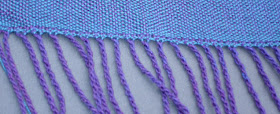A few tips in weaving prettier fabric:
Weave in small increments such as an inch or a small repeat midway between the breast beam and beater. If you try to get the most out of an advance of the warp by weaving right up next to the breast beam and all the way to the beater, your edges will be uneven due to the differentiation of the weft arc.
Don't handle the selvages. It will change the tension and the selvages will wave lengthwise when you take it off the loom and will not come out with wet-finishing.
Maintain an even beat and develop a rhythm.
When you leave the loom for a period more than a few hours, release the tension on your warp. When you return to weave, adjust the tension. Prior to throwing the first pick, beat once lightly on a closed shed. (The last pick will have traveled just a little so that you will be able to see it off the loom.) Open the next shed and throw a pick.
Step 61: When you reach the end of a bobbin, overlap in the same shed by a few bobbins and continue. If you're weaving with a hand painted, variegated yarn, begin weaving with the same color of the end of the last bobbin. This is particularly true if you're working with a directional colorway like the ones I paint as the color will continue in the same direction.

Step 62: This is a close-up of the step above. You will leave these ends until you have washed your scarf.

Step 63: Final end hem-stitched and the fabric is off the loom. See the weft ends that were overlapped? When the scarf is wet-finished and completely dry, these ends will be trimmed off next to the fabric.

Step 64: This picture shows both sides of the fabric. There is really no wrong side. But the side on the left was the one facing up on the loom when hem-stitched. Hem-stitching looks a little different on the opposite side. So, I recommend twisting on the same side of the fabric. The white spots you see are in the loom waste. I could have decided to trim the fringe shorter but most likely, when the fringe is twisted, it will barely be noticed and won't bother me.

Step 65: Close-up picture of hem-stitching and twisted fringe.

Step 66: Picture of finished stole after wet-finishing and a good hard-press.

No comments:
Post a Comment